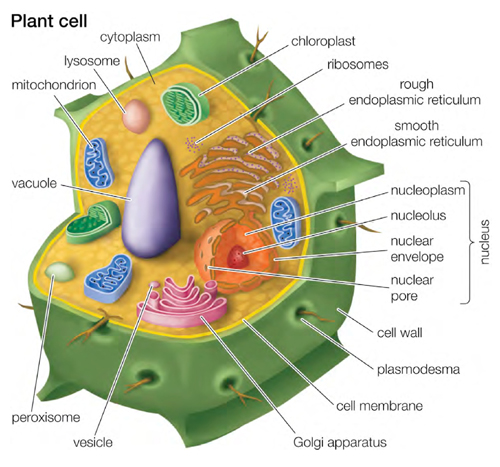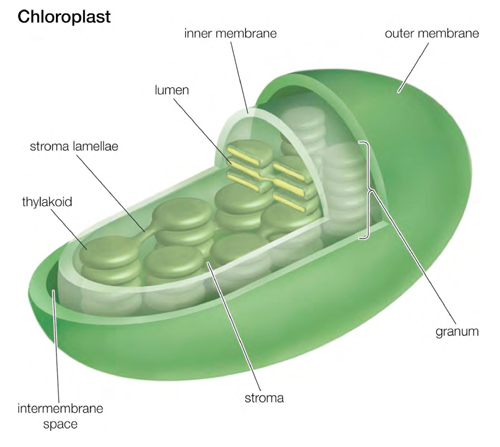
Plant cells are much easier to see under a microscope than animal cells for two reasons. The first reason is that plant cells are generally larger than animal cells are. In addition, plant cells have thick cell walls outside the plasma membranes, which makes them easy to identify. Animal cells have only thin, flexible cell membranes. A plant’s thick cell wall is made of a rigid substance called cellulose, which helps the plant cell maintain its shape. Cellulose also protects the plant cell from mechanical damage. Cellulose is made up of linked glucose units. It is the major raw material component used in the production of certain manufactured fibers, such as rayon. Historically, paper was produced from cotton plants, which are 91 percent cellulose. Today, hardwoods and softwoods provide the major source of papermaking fibers, which are only about 60 percent cellulose.
Though they have numerous organelles and a nucleus, plant cells are primarily composed of a large central vacuole, which fills at least 80 percent of a mature plant cell. The vacuole is a large watery bag near the center of a cell. It stores chemicals and waste products that would be dangerous to the cell if they built up in the cytoplasm.
Like animal cells, plant cells have a cell membrane, cytoplasm with a variety of organelles, and a nucleus. Unlike animal cells, they also have a rigid cell wall and feature large vacuoles and chloroplasts. Encyclopædia Britannica, Inc.
The large central vacuole and the thick cell wall work together to aid the growth process for the entire plant. Most plant growth occurs when the large central vacuole and the cytoplasm absorb water. By absorbing water, plant cells elongate, or grow longer. By contrast, animal cells grow by synthesizing organic molecules and increasing their cytoplasm. When the vacuole absorbs water in plant cells, it expands the contents of the cells within the cell walls, causing the plant to become stiff and have turgor pressure. If there is not enough water in the vacuoles, the plant will wilt.
Transpiration is the process in which water passes through a plant. The outer cells of the leaves are constantly losing water through evaporation. This is especially true on a hot, sunny summer day when water evaporates quickly. When this occurs, the plant cell’s vacuoles shrink because they are losing water. Therefore, the concentration of minerals and sugars in the vacuoles of leaf surface cells becomes higher than the concentration of sugars in the vacuoles of cells inside the leaf, which are not near the warm surface. Water then travels from the inner cells with a higher concentration of water to those on the surface with a lower concentration of water. This causes more water to be pulled up through the stem and roots. This process of transpiration occurs constantly. However, the rate varies depending upon how much water is in the soil.
WHY DO PLANTS WILT?
If a plant does not absorb enough water, it wilts. When you see your plant leaves drooping, it is because the turgor pressure in its cells has dropped and the cells can no longer support the plant. After a while, the plant will start to die and will undergo plasmolysis. In this process, the vacuoles of the plant cells shrivel and pull the cytoplasm away from the cell walls, causing the plant to lose strength and die.
CHLOROPLASTS
Unlike animal cells, plant cells and certain types of algae contain chloroplasts. These organelles contain a green pigment called chlorophyll. All green parts of the plant contain chloroplasts, including the stem, the leaves, and, sometimes, unripe fruit. During the process of photosynthesis, the chlorophyll molecules in the chloroplasts capture light energy from the sun and store it in a chemical form. Photosynthesis provides energy for all living things in the form of glucose.
The pigment in the chloroplasts, known as chlorophyll, traps the light energy. If you have ever worn a black shirt on a very sunny day, you know that dark colors absorb more light than light colors. You most likely felt warmer than normal because the more pigment a substance has, the more light it will trap.
Chloroplasts belong to a group of organelles, known as plastids, which are found in the cytoplasm of plant cells. Chromoplasts are another type of plastid. They contain pigments called carotenoids, which give fruits, flowers, and autumn leaves their orange and yellow hues. Carotenoids can be a variety of colors, while chlorophyll is always green. Sometimes, chloroplasts will convert into chromoplasts. When this occurs in fruit, the color changes from green to a color characteristic of that fruit. This color change is a sign that the fruit is ripe and ready to eat.

The chloroplast is enclosed in a double membrane, within which are the stroma (a matrix containing dissolved enzymes) and the lamellae (internal membranes folded into closed disks, the thylakoids). Encyclopædia Britannica, Inc.
Chlorophyll, the green pigment inside the chloroplasts, absorbs red and blue light rays from the sun, and it reflects green light rays. This is why leaves are green. In autumn, the chlorophyll in most plants breaks down. Other pigments, such as carotene and tannin, become more abundant. These other pigments reflect orange, yellow, and brown light, making the leaves display a stunning array of fall colors.

Some of the pigments that make fall foliage so colorful are the orange carotenes and the yellow xanthophylls. Jeremy Woodhouse/Stockbyte/Getty Images
Cacti adapted to live in places with little water. Given that most water loss in plants happens through the leaves, the leaves of cacti have been reduced to form the protective spines. Oleg Znamenskiy/Shutterstock.com
Some plant cells contain more chloroplasts than other plant cells. The amount of chloroplasts is determined by the position of the cells inside the plant. Since leaves are the main sites of photosynthesis, cells on the inside of the leaves contain the most chloroplasts. In most plants, the flat surface of the leaves provides a large area for sunlight absorption. The chloroplasts of cacti are located in the green spongy stem rather than the leaves (which have been modified to form the cactus spines) and photosynthesis thus occurs there.